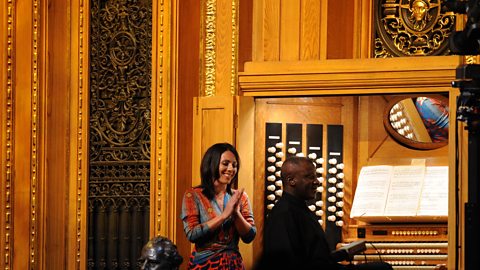Seven Classic Christmas Organ Pieces

On 10 December, London’s Temple Church will be ringing to the sound of Oliver Messiaen’s La nativité du Seigneur, with interspersed choral music from the ���˿��� Singers. Organist Ashley Grote has the honour of playing Messiaen’s festive masterpiece on what will be the French composer’s birthday. Ahead of the performance, we take a quick look at this mighty work for organ alongside six other Christmas classics
‘La nativité du Seigneur’ by Olivier Messiaen
Messiaen wrote his La nativité du Seigneur (‘The Nativity of the Lord’) in the summer of 1935 while on an extended sojourn to the French Alps. The piece is a series of religious frescos, a large-scale expression of his deep-seated Catholicism.
In each of La nativité’s nine movements – or ‘meditations’ – Messiaen explores a different element of the Christmas story, moving between character portraits (‘The Shepherds’; ‘The Angels’) and theological contemplation (‘Eternal Designs’).
This fresh, sensual music contains some of the earliest examples of Messiaen’s use of ‘Modes of Limited Transposition’, a series of scales he later devised for their symmetry and symbolism.
There are also glimpses of the other major influence on his music: birdsong. You can hear this most clearly in the final mediation, ‘Dieu parmi nous’ (‘God Among Us’). Here, Messiaen draws together many of the ideas and themes from the preceding movements.
Listen out for flashes of rhythmic flexibility in the upper registers – the unmistakable influence of Messiaen’s feathered friends.

La nativité du Seigneur – No. 9, Dieu parmi nous
Wayne Marshall performs the ninth ‘meditation’ at the First Night of the 2008 Proms
Three Versets on ‘Away in a manger’ by Mark Blatchly
In this short piece, British organist Mark Blatchly dusts off a Christmas classic and gives it the tinsel treatment. An opening ‘verset’ – a fairly conventional arrangement of ‘Away in a manger’ – is followed by two variations, each with a different feel.
The first skips along like a jolly sleigh ride, while the second speaks of candle-lit contemplation. Listen out for the tubular bells in the last few bars. Ringing in the festive season, perhaps?
Chorale Prelude on ‘Es ist ein Ros entsprungen’ by Johannes Brahms
Another take on a Christmas carol – this time a German one. ‘Es ist ein Ros entsprungen’ – most commonly translated as ‘Lo, how a rose e’er blooming’ – first appeared in print in 1599, though the original composer remains a mystery.
Among the many to recycle the melody are Arnold Schoenberg, Jan Sandström and Sting. This particular version, by Brahms, is part of the composer’s 11 Chorale Preludes for organ, written right at the end of his life. It’s a shy little arrangement, brief but glowing with Yuletide kindness.
‘Vom Himmel hoch, da komm ich her’ by J. S. Bach
J. S. Bach’s Orgelbüchlein (‘Little Organ Book’) is a set of 46 chorale preludes for organ, written while the great man was organist to the ducal court in Weimar. Each piece is based on an existing Lutheran chorale, but Bach spruces them up with his signature contrapuntal chicanery.
‘Vom Himmel hoch, da komm ich her’ (‘From Heaven on high I come here’) is a Christmas hymn written by Martin Luther himself (we think). It forms the basis of the seventh prelude in Bach’s collection, as well as several other pieces he wrote for organ later in life.
Dónal McCann, Organ Scholar at King’s College, Cambridge, played this chorale prelude as a voluntary during 2019’s Festival of Nine Lessons and Carols. Although under a minute long, its dense four-part counterpoint packs a Christmas punch that easily compensates for its modest stature.

‘Nativité’ by Jeanne Demessieux
Jeanne Demessieux was a Parisian concert organist and composer who allegedly had over 2,500 pieces memorised – including the complete organ works of Bach, Franck, Liszt and Mendelssohn.
She wrote this inquisitive little piece during the final weeks of 1943. Her aim was ‘to make something light, based on the shivering, poverty-stricken tenderness of the Nativity’. A salve to the horrors of Nazi-occupied Paris.
‘White Christmas’ by Irving Berlin, arr. Ethel Smith
This next piece sits right at the other end of the organ-music spectrum. Ethel Smith – not to be confused with Ethel Smyth – was a Billboard Top 20 recording artist and Hollywood star who made her name playing arrangements of pop songs on the Hammond organ.
In 1949 she released the album Christmas Music, the penultimate track of which is a smoochy arrangement of Irving Berlin’s ‘White Christmas’. Accompanied by chimes, celesta and vibraphone, it’s the unmistakable sound of mid-century American festivity.
‘The Holy Boy’ by John Ireland, arr. Alec Rowley
‘The Holy Boy’ is probably John Ireland’s best-known melody. He originally wrote it for piano – part of his four Preludes for Piano, published in 1915 – but kept returning to it, making arrangements for various combinations of instruments right up until 1941.
This version was put together by fellow composer Alex Rowley in 1919. At first listen it sounds almost childishly simple. But delve a little deeper and you’ll find rich harmony and shifting textures. A masterclass in subtlety from Ireland.